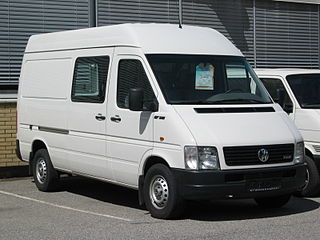
The Volkswagen Golf is a compact car/small family car (C-segment) produced by the German automotive manufacturer Volkswagen since 1974, marketed worldwide across eight generations, in various body configurations and under various nameplates – including as the Volkswagen Rabbit in the United States and Canada, and as the Volkswagen Caribe in Mexico (Mk1).
Wilhelm Karmann GmbH, commonly known as Karmann, was a German automobile manufacturer and contract manufacturer based in Osnabrück, Germany. Founded by Wilhelm Karmann in 1901, the company specialised in various automotive roles, including design, production and assembly of components for a wide variety of automobile manufacturers, including Chrysler, Porsche, Mercedes-Benz and Volkswagen Group.

The Volkswagen Citi Golf is a right-hand drive 5-door hatchback manufactured and marketed by Volkswagen in South Africa from 1984 to 2009 as a facelifted version of the first generation Volkswagen Golf Mk1, which ceased production in Germany in 1983.

The Volkswagen LT is the largest light commercial panel van produced by Volkswagen from 1975 to 2006, before being replaced by the Crafter. Two generations were produced.
The Volkswagen Group A platform is an automobile platform shared among compact and mid-size cars of the Volkswagen Group.

A crossover, crossover SUV, or crossover utility vehicle (CUV) is a type of automobile with an increased ride height that is built on unibody chassis construction shared with passenger cars, as opposed to traditional sport utility vehicles (SUV), which are built on a body-on-frame chassis construction similar to pickup trucks.

The Volkswagen New Beetle is a compact car, introduced by Volkswagen in 1997, drawing heavy inspiration from the exterior design of the original Beetle. Unlike the original Beetle, the New Beetle has its engine in the front, driving the front wheels, with luggage storage in the rear. It received a facelift in 2005 and was in production until 2011, almost fourteen years since its introduction.

ARO was a Romanian off-road vehicle manufacturer located in Câmpulung. The first ARO vehicles were produced in 1957, and the last in 2003. For a short while, Daihatsu-powered AROs were sold in Spain and produced in Portugal under the brands. In Italy, AROs were produced and sold under the ACM brand, often fitted with Volkswagen engines.
Canadian Car of the Year winners, as chosen by the Automobile Journalists Association of Canada:

ARO 10 was an off-road vehicle produced by ARO and manufactured in Romania. It shares auto-parts with Dacia 1300, from engine to front axle, and was inspired by the Renault Rodeo and Citroën Méhari.

The Geneva International Motor Show was an annual auto show held in March in the Swiss city of Geneva.

The International Motor Show Germany or International Mobility Show Germany, in German known as the Internationale Automobil-Ausstellung, is one of the world's largest mobility trade fairs. It consists of two separate fairs, that subdivided in 1991. While the IAA Mobility displays passenger vehicles, motorcycles and bikes, the IAA Transportation specializes in commercial vehicles. Before the separation, the show was held solely at the Messe Frankfurt.

The Los Angeles Auto Show, also known as the LA Auto Show, is an auto show held annually at the Los Angeles Convention Center in Los Angeles, California, United States. It is open to the public for ten days, filling 760,000 square feet (71,000 m2) of exhibit space. Since 2006 the event is held in November or December.

The C-segment is the 3rd category of the European segments for passenger cars and is described as "medium cars". It is equivalent to the Euro NCAP "small family car" size class, and the compact car category in the United States.

The Volkswagen Golf Mk4 is a compact car, the fourth generation of the Volkswagen Golf and the successor to the Volkswagen Golf Mk3. Launched in October 1997 for the 1998 model year, it was the best selling car in Europe in 2001.

The Volkswagen Golf Mk3 is a medium-sized compact family car. It is the third generation of the Volkswagen Golf and the successor to the Volkswagen Golf Mk2, which was produced by Volkswagen from August 1991 to 2002.

The Volkswagen Golf Mk2 is a hatchback, the second generation of the Volkswagen Golf and the successor to the Volkswagen Golf Mk1. It was Volkswagen's highest volume seller from 1983 and ended in (German) production in late 1992, to be replaced by the Volkswagen Golf Mk3. The Mk2 was larger than the Mk1; its wheelbase grew slightly, as did exterior dimensions. Weight was up accordingly by about 120 kg (260 lb). Exterior design, developed in-house by VW design director Schäfer, kept the general lines of its Giugiaro-designed predecessor, but was slightly more rounded. All told, about 6.3 million second-generation Golfs were built.

The Volkswagen Golf Mk1 is the first generation of a small family car manufactured and marketed by Volkswagen. It was noteworthy for signalling Volkswagen's shift of its major car lines from rear-wheel drive and rear-mounted air-cooled engines to front-wheel drive with front-mounted, water-cooled engines that were often transversely-mounted.

The Volkswagen T-Roc is a compact crossover SUV (C-segment) manufactured by German automaker Volkswagen. It was unveiled at the 2017 Frankfurt Motor Show, and launched in November 2017. It is based on the Volkswagen Group MQB A1 platform, and generally has been considered as the SUV equivalent of the C-segment Golf. It is positioned between the Tiguan and the slightly smaller T-Cross, while being approximately the same size as the Taigo.

















